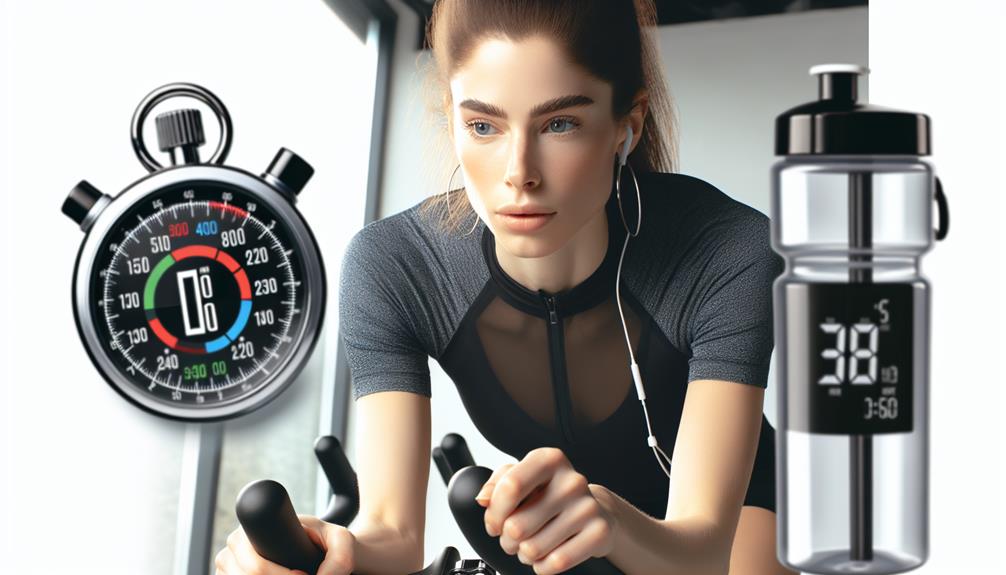Interval cycling plans are the ultimate way to ramp up our biking performance. With structured workouts, we boost endurance and build strength on the bike. By mixing high-intensity bursts with recovery periods, we challenge our bodies and target heart rate zones effectively. From power intervals to active recovery strategies, each session contributes to improved speed and power. Balancing strength training and proper nutrition fuels our progress. Join us in exploring the world of interval cycling plans for enhanced cardio and strength gains – uncover the secrets to cycling success!
Benefits of Interval Cycling Plans
Interval cycling plans offer a multitude of benefits that can significantly enhance our overall fitness and performance. By incorporating intervals into our cycling routine, we can experience increased endurance and improved performance on the bike. These structured workouts push us out of our comfort zones, challenging our bodies to adapt and become stronger.
Through interval cycling, we can boost our cardiovascular capacity and build muscular strength. The alternating high-intensity efforts and recovery periods help us improve our anaerobic threshold, allowing us to sustain higher power outputs for longer durations. This increased endurance translates not only to better performance during rides but also to enhanced overall fitness levels.
Moreover, interval training stimulates physiological adaptations that lead to enhanced speed, power, and efficiency. By consistently integrating interval cycling into our training regimen, we can push our limits, break through plateaus, and reach new levels of performance. So, let's embrace the challenges and rewards of interval cycling to elevate our fitness journey to new heights.
Understanding Interval Training
Let's delve into the core principles of effective interval training to maximize our fitness gains and performance improvements. Interval training involves alternating between high-intensity efforts and lower-intensity recovery periods. The effectiveness of interval training lies in its ability to push our bodies outside our comfort zones, challenging both our cardiovascular system and muscles.
There are various interval variations to consider when designing your workouts. These can include short, intense bursts of effort followed by longer recovery periods or sustained efforts at a slightly lower intensity. Understanding your heart rate zones is crucial for effective interval training. By working at different training intensities within these zones, you can target specific physiological adaptations and improve both your aerobic and anaerobic capacities.
To make the most of your interval training sessions, ensure you plan your workouts strategically, considering factors such as interval duration, intensity, and recovery periods. By incorporating these elements thoughtfully, you can tailor your training to meet your fitness goals and see significant improvements in your cycling performance.
Designing Your Cycling Workouts

To enhance our cycling performance and achieve our fitness goals, crafting well-planned cycling workouts is key. When designing your cycling workouts, consider incorporating the following elements:
- Power Intervals: These intense bursts of effort followed by short recovery periods are fantastic for building strength and increasing your overall power output on the bike.
- Endurance Drills: Endurance is crucial for long rides or races. Include longer, steady-state efforts in your workouts to improve your cardiovascular fitness and stamina.
- Sprint Training: Sprints help improve your speed and explosiveness. Incorporate short, all-out sprints into your sessions to enhance your sprinting abilities and overall cycling performance.
High-Intensity Interval Sessions
Get ready to push your limits and elevate your cycling performance with high-intensity interval sessions that will challenge and transform you. Incorporating sprint intervals into your training regimen can significantly boost your cardiovascular endurance and strength on the bike. These short bursts of intense effort followed by brief recovery periods are a game-changer for cyclists looking to take their fitness to the next level.
HIIT benefits extend beyond just physical gains; they also enhance mental toughness and overall performance. By pushing yourself to the limit during these sessions, you're training your body to adapt and become more efficient. To maximize the effects of high-intensity intervals, it's crucial to incorporate proper recovery techniques into your routine. This includes adequate rest, nutrition, and hydration to ensure your body can repair and grow stronger.
In addition to sprint intervals, don't forget the importance of balancing your training with endurance rides. These longer, steady-state efforts help improve your aerobic capacity and overall cycling efficiency. By combining sprint intervals with endurance rides, you create a well-rounded training program that will set you up for success on the bike.
Active Recovery Strategies

Incorporate active recovery strategies into your routine to optimize your cycling performance and facilitate faster post-workout recovery. Taking care of your body during the recovery phase is just as crucial as pushing yourself during the high-intensity intervals. Here are some effective strategies to help you recover better and get back on the bike feeling stronger than ever:
- Foam Rolling: Spend some time foam rolling your muscles to release tension and improve blood flow. This can help reduce muscle soreness and speed up the recovery process.
- Stretching Techniques: Incorporate dynamic stretches or static stretches to improve flexibility and prevent muscle tightness. Stretching after a workout can help reduce the risk of injury and improve your overall performance.
- Active Rest Days: On rest days, consider going for a leisurely bike ride or engaging in other low-impact activities to keep your body moving without putting too much strain on your muscles. Active recovery can help prevent stiffness and maintain your fitness level.
Monitoring Progress and Adjustments
As we progress with our interval cycling plans, it becomes valuable to track our performance and make necessary adjustments to ensure continued growth and success in our training regimen. Progress tracking is essential in understanding how our bodies are responding to the workouts we're completing. Keep a journal or use a fitness app to monitor metrics like average speed, distance covered, heart rate zones, and perceived exertion levels. By doing so, we can identify trends, celebrate improvements, and pinpoint areas that may need more attention.
When it comes to workout adjustments, remember that our bodies are adaptable. To keep progressing, we need to challenge ourselves by increasing intensity, duration, or frequency gradually. If a certain interval feels too easy, push a little harder next time. On the flip side, if a specific session leaves you overly fatigued, consider dialing it back slightly. Listen to your body, trust your instincts, and don't be afraid to experiment with different approaches until you find what works best for you. Remember, progress is a journey, and making small adjustments along the way will help you reach your cycling goals faster and more efficiently.
Incorporating Strength Training

How can we maximize our cycling performance by integrating strength training into our routine? Strength training plays a vital role in enhancing our cycling performance by improving power, endurance, and overall strength.
Here are some key points to consider when incorporating strength training into your cycling routine:
- Focus on compound movements: Incorporate exercises like squats, deadlifts, and lunges to target multiple muscle groups simultaneously, mimicking the movements used in cycling.
- Include plyometric exercises: Incorporating plyometric exercises such as box jumps and explosive leg presses can help improve your power output and speed on the bike.
- Don't forget core strength: A strong core is essential for stability and efficient power transfer while cycling. Include exercises like planks, Russian twists, and supermans to strengthen your core muscles.
Nutrition for Cycling Performance
To fuel our cycling performance optimally, we must prioritize smart and balanced nutrition choices. Hydration tips are crucial – remember to drink water consistently throughout the day and during your rides. Pre-ride fueling is essential for sustained energy; opt for a mix of carbohydrates and proteins like a banana with nut butter or Greek yogurt with granola.
After your workout, focus on post-workout recovery. Replenish your body with a combination of protein and carbohydrates to aid muscle repair and glycogen replenishment. Performance supplements can be beneficial, but always consult with a healthcare professional or nutritionist before incorporating them into your routine.
Rest and Recovery Importance
Rest and recovery play a crucial role in optimizing our cycling performance and overall well-being. When it comes to enhancing our cycling journey, integrating proper rest and recovery practices are vital.
Here are some key points to consider:
- Recovery Techniques: Implementing effective recovery techniques such as foam rolling, stretching, and massage can aid in reducing muscle soreness and enhancing flexibility, promoting faster recovery after intense cycling sessions.
- Injury Prevention: Prioritizing rest days and incorporating cross-training activities can help prevent overuse injuries, allowing our bodies to recover and strengthen adequately.
- Mental Rejuvenation: Rest and recovery aren't only essential for physical well-being but also for mental rejuvenation. Taking time off the bike can help reduce stress levels, improve focus, and reignite our passion for cycling.
Long-Term Planning and Sustainability
Optimizing our cycling journey for long-term success involves strategic planning and a focus on sustainability to ensure continuous improvement and enjoyment in our rides. When it comes to long-term progress, consistency is key. Building sustainable routines that align with our goals and lifestyle is crucial for lasting success on the bike.
To achieve long-term progress, it's essential to set realistic and achievable goals. Break down your objectives into smaller milestones and celebrate each accomplishment along the way. This not only keeps you motivated but also helps track your development over time.
Incorporating variety into your cycling routine can prevent burnout and keep things exciting. Explore different routes, try new interval workouts, or join group rides to keep your rides fresh and engaging. Remember, sustainability is about finding a balance that allows you to stay committed to your cycling journey in the long run.
Frequently Asked Questions
Can Interval Cycling Plans Help With Weight Loss in Addition to Improving Cardio and Strength?
Absolutely, interval cycling plans are fantastic for weight loss. Through combining interval training and cycling benefits, we torch fat and improve cardio and strength. It's about pushing ourselves and reaping the rewards. Let's ride!
Are There Specific Interval Cycling Workouts Recommended for Beginners Versus Advanced Cyclists?
For beginners, we suggest starting with gradual increases in intensity and duration to build endurance and confidence. Advanced riders can push boundaries with high-intensity intervals and longer sprints to enhance performance and reach new goals.
How Often Should Intervals Be Incorporated Into a Cycling Training Plan for Optimal Results?
We find that incorporating intervals regularly, about 2-3 times a week, yields optimal results. Consistency is key to improving cardio and strength. Vary intensity levels and duration for a well-rounded training plan that keeps challenging and pushing us towards progress.
Can Interval Cycling Plans Help Improve Overall Endurance for Longer Rides or Races?
Interval cycling plans are key to endurance building. By varying interval frequency and incorporating different types, we prepare for races and longer rides efficiently. Consistent training with intervals boosts both cardio and strength on the bike.
Are There Any Specific Recommendations for Incorporating Interval Cycling Into a Cross-Training Routine for Overall Fitness Benefits?
When it comes to cross-training, we recommend incorporating interval cycling for strength training benefits. To optimize results, focus on recovery methods like proper nutrition and rest. Consistency is key, so keep pushing and enjoy the fitness gains!
Conclusion
As we pedal towards our goals, let's remember the power of interval cycling plans. By pushing ourselves through high-intensity sessions and embracing active recovery, we can boost our cardio and strength on the bike.
Don't forget the importance of incorporating strength training, fueling our bodies with proper nutrition, and allowing ourselves time to rest and recover.
With a long-term plan in place, we can sustain our progress and reach new heights in our cycling journey. Keep pushing, keep pedaling, and keep thriving!













